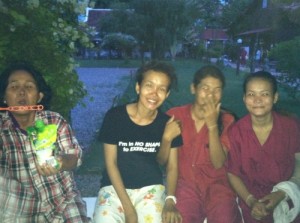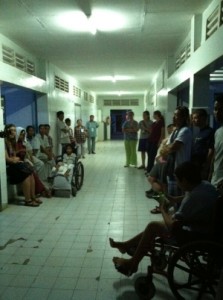 Mission to Cambodia 2013
Mission to Cambodia 2013
from Paige Nunnelley
 Our last day in Battambang was very bittersweet. We are all excited about the upcoming return home, but we have all fallen in love with the people of Cambodia. Personally, I also fell in love with the Handa Emergency Hospital in Battambang. People in Cambodia ride “motos,” or motorcycles almost all the time. And the traffic in Cambodia is terrifying. Because of that combination, there are way too many moto accidents. As we walked into the hospital for the first time, we saw many legs in traction, head wounds, broken pelvises, etc. Trauma injuries. Unfortunately, we also saw some children who had found something in the ground and began playing with it, only to find out it was a mine. As an earlier blogger mentioned, the rainy seasons bring old mines from the 1970s back to the surface, and can even wash them into new areas. Somebody can be walking the same path for 20 years, and one day there could be a mine waiting for them. I can only imagine how it must feel to know that there could be bombs beneath your feet at any moment, just waiting for someone to step on it. The Handa Hospital is the only treatment option many of these trauma victims have. If you are brought through the doors of a private clinic, you are charged $600. That’s in a country where surgeons can make about $500/month. Handa provides care on a sliding scale. You have to pay something, but their SAO office is usually able to work out arrangements with the patient or their family. I’m so grateful that the Handa foundation chose to save this hospital from shutting down after their previous supporters removed funding. I don’t know what these people would do without it.
Our last day in Battambang was very bittersweet. We are all excited about the upcoming return home, but we have all fallen in love with the people of Cambodia. Personally, I also fell in love with the Handa Emergency Hospital in Battambang. People in Cambodia ride “motos,” or motorcycles almost all the time. And the traffic in Cambodia is terrifying. Because of that combination, there are way too many moto accidents. As we walked into the hospital for the first time, we saw many legs in traction, head wounds, broken pelvises, etc. Trauma injuries. Unfortunately, we also saw some children who had found something in the ground and began playing with it, only to find out it was a mine. As an earlier blogger mentioned, the rainy seasons bring old mines from the 1970s back to the surface, and can even wash them into new areas. Somebody can be walking the same path for 20 years, and one day there could be a mine waiting for them. I can only imagine how it must feel to know that there could be bombs beneath your feet at any moment, just waiting for someone to step on it. The Handa Hospital is the only treatment option many of these trauma victims have. If you are brought through the doors of a private clinic, you are charged $600. That’s in a country where surgeons can make about $500/month. Handa provides care on a sliding scale. You have to pay something, but their SAO office is usually able to work out arrangements with the patient or their family. I’m so grateful that the Handa foundation chose to save this hospital from shutting down after their previous supporters removed funding. I don’t know what these people would do without it.
 I have also been reminded here of how blessed I am with my education. I go to a wonderful nursing school, with professors who know so much and try to cram every bit of that knowledge into our heads, too. Sometimes it seems overwhelming or frustrating, but I know that I will never look at it this way again. It is an amazing gift that we take for granted. The nurses in Cambodia want to learn. They have no opportunity to learn. This is where visitors come in. Educated individuals who can share their knowledge. Yesterday, we taught about the pain scale and assessing pain regularly. Many patients in Cambodia, especially the men, do not cry out when they are in pain. They may not even show the pain through facial expression. So usually the nurses look at the patient and write down “mild pain.” I can promise that the patient with a femur fracture in traction is not in mild pain. But the pain is such a part of life that people don’t ask for medicine. And unfortunately, there is no real pain medicine to give even if they ask. The hospitals have Tylenol and Ibuprofen and some medications that make you sleepy. No narcotics. There is no morphine. Narcotics are very expensive to purchase and there are security difficulties in a third-world countries, so there is simply none available. I was heartbroken today by a little boy with a femur fracture. He was probably 9 or 10 years old and I brought some bubbles over to play with him. Someone translated for him that he could not play – that he could not even smile because he hurts too badly. I went to check his chart and saw that he had last received his medicine at 6 am yesterday. This poor little boy did not even have Ibuprofen for the pain for over 30 hours. I immediately asked someone to get him some pain medicine, and everyone was confused. I was told that medication can only be given if they ask for it. I stuck around and discussed with them what had been taught yesterday with the pain scale, explaining that the patients here are too strong and will not ask for pain medicine, but that patients heal more slowly when they are in pain. Thankfully, the nurses listened and the little boy got medication quickly. I know it probably didn’t do much, but any relief would be good.
I have also been reminded here of how blessed I am with my education. I go to a wonderful nursing school, with professors who know so much and try to cram every bit of that knowledge into our heads, too. Sometimes it seems overwhelming or frustrating, but I know that I will never look at it this way again. It is an amazing gift that we take for granted. The nurses in Cambodia want to learn. They have no opportunity to learn. This is where visitors come in. Educated individuals who can share their knowledge. Yesterday, we taught about the pain scale and assessing pain regularly. Many patients in Cambodia, especially the men, do not cry out when they are in pain. They may not even show the pain through facial expression. So usually the nurses look at the patient and write down “mild pain.” I can promise that the patient with a femur fracture in traction is not in mild pain. But the pain is such a part of life that people don’t ask for medicine. And unfortunately, there is no real pain medicine to give even if they ask. The hospitals have Tylenol and Ibuprofen and some medications that make you sleepy. No narcotics. There is no morphine. Narcotics are very expensive to purchase and there are security difficulties in a third-world countries, so there is simply none available. I was heartbroken today by a little boy with a femur fracture. He was probably 9 or 10 years old and I brought some bubbles over to play with him. Someone translated for him that he could not play – that he could not even smile because he hurts too badly. I went to check his chart and saw that he had last received his medicine at 6 am yesterday. This poor little boy did not even have Ibuprofen for the pain for over 30 hours. I immediately asked someone to get him some pain medicine, and everyone was confused. I was told that medication can only be given if they ask for it. I stuck around and discussed with them what had been taught yesterday with the pain scale, explaining that the patients here are too strong and will not ask for pain medicine, but that patients heal more slowly when they are in pain. Thankfully, the nurses listened and the little boy got medication quickly. I know it probably didn’t do much, but any relief would be good.
 This was such a full day that I can’t go into detail about everything we did. Some students toured a physical rehabilitation center and spinal injury hospital in the city. These were government-run facilities and I was told that the condition in those hospitals was very poor in comparison to the privately funded hospitals we’ve been working in. Other students, including myself, got to witness some more surgeries. I observed surgery on one of the children that had been injured by the mine they were playing with. Knowing he was going to wake up and have no pain medication was heart-wrenching, but that is just the way of life here. People are stronger here. Another group of students went to a cave in the afternoon where you can see thousands of bats fly out at 5:30 pm every day. I was still at the hospital, but everyone that went said it was an amazing experience.
This was such a full day that I can’t go into detail about everything we did. Some students toured a physical rehabilitation center and spinal injury hospital in the city. These were government-run facilities and I was told that the condition in those hospitals was very poor in comparison to the privately funded hospitals we’ve been working in. Other students, including myself, got to witness some more surgeries. I observed surgery on one of the children that had been injured by the mine they were playing with. Knowing he was going to wake up and have no pain medication was heart-wrenching, but that is just the way of life here. People are stronger here. Another group of students went to a cave in the afternoon where you can see thousands of bats fly out at 5:30 pm every day. I was still at the hospital, but everyone that went said it was an amazing experience.
That evening, we sang some praise and worship songs in the hallway of the hospital again, dancing around and blowing bubbles everywhere. Both adults and children came out to see, and we all had a blast. It was a wonderful way to end the day.
Today definitely reminded me how much they need people here. We don’t have to be doing medical things to make a difference. A smile to a sick woman, music that made a girl with a brain tumor sit up and speak again, bubbles that make a child laugh when they thought they would never laugh again. That’s the stuff that matters.
Matthew 5:3-4 – “Blessed are the poor in spirit, for theirs is the kingdom of Heaven. Blessed are those who mourn, for they will be comforted.”
